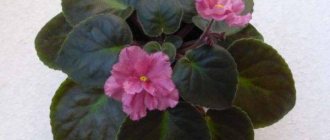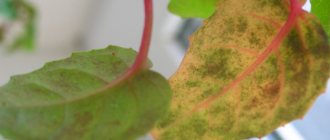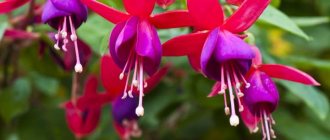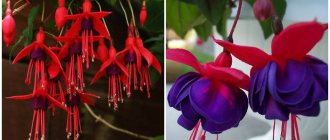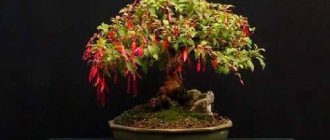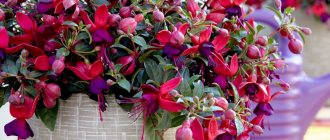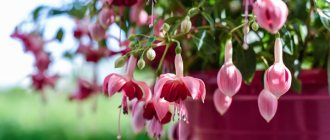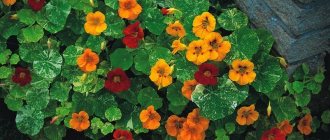Graceful, bright, attractive fuchsia flowers hang like jewelry among the delicate foliage. They resemble little forest fairies, dressed in dresses of various colors: red, white, pink. The unusual shape is the reason for the appearance of another popular name - “elf flower”. The plant requires simple care, although to avoid problems it is worth familiarizing yourself with its features. For example, how to care for fuchsia in order to fully reveal its varietal characteristics.
Curious pedigree of the plant
Natural types of fuchsia are witnesses to the history of the powerful Indian people, the successor of the traditions of the Inca Empire in South America. This beautiful flower was brought to Europe from Chile in the 18th century. Straight to the English royal court.
The genus of plants Fuchsia belongs to the fireweed family (Onagraceae) and has 107 species growing in natural conditions. Breeders have created hybrid fuchsia, many of its varieties, representing an incredible palette of petals.
Interesting facts:
- The Frenchman C. Plumier, who discovered the species in 1696 on a scientific expedition to the Greater Antilles, gave it the name in honor of L. Fuchs, a German botanist.
- In 1853, the first fully double fuchsia variety was developed.
- The father of genetics, Gregor Mendel, called this flower his favorite plant and chose it for his coat of arms.
Wild fuchsias are annual or perennial plants that live on the edges of tropical forests at altitudes of up to 3000 m in the light shade of tall trees. Flowers in the room also require high humidity and shading from the scorching sun. Getting acquainted with tips on how to grow fuchsia should begin with studying the varieties and growing conditions.
Bush and ampel forms of fuchsias
All fuchsias are characterized by thin branches. Young stems have a reddish tint. The leaves are oval or ovate, with small teeth along the contour. The upper part of the branches is strewn with large flowers. Or rather, they hang down, resembling the silhouette of a ballerina, an elf or a lantern.
The calyx of fuchsia flowers is corolla-shaped, brightly colored. It has four pointed, strongly bent sepals. The corolla is tubular, often has the shape of a fluffy skirt, the stamens are long. The flowers vary in size and color, and the color of the sepals usually contrasts with the corolla.
The following varieties of fuchsia (group) are distinguished:
- bush;
- ampelous (hanging);
- semi-ampel.
The division into groups is somewhat arbitrary. Most fuchsias have both erect and drooping shoots, i.e. they are semi-ampeloid. Bush plants grow upwards and rarely droop.
In some classifications, fuchsia varieties are divided into bush and creeping forms. Creeping or hanging varieties are grown in hanging baskets, flowerpots, and used to decorate the walls of rooms, verandas and terraces.
Low-growing fuchsias in a pot are resistant to dry air and are suitable for beginner gardeners.
How to care for fuchsia at home
Graceful bushes bloom profusely and reproduce easily. Usually, growing and caring for fuchsia at home does not cause difficulties. This is why the plant has gained great popularity among gardeners in many countries.
The only whim of fuchsia is that it should not be rearranged or rotated during flowering. It is also recommended to avoid heating and drying out the root ball.
Temperature
Optimal temperature conditions during the growing season: during the day from 20 to 24°C, at night 15–18°C. The fuchsia flower needs fresh air. The beauty feels good in the summer on a loggia or balcony, where the plant needs to be shaded at midday and protected from drafts.
Lighting
The ideal location is windows facing southeast and southwest. Western and eastern windows, a balcony, a terrace are suitable. If you provide shade during the summer at noon, you can grow it on the south side. Fuchsia varieties with light-colored flowers can withstand the sun better.
Completely shady places are not desirable for the plant. Although fuchsia is patient even with them. Just when choosing a house flower for a north window, do not expect abundant and long-lasting flowering.
Watering
Fuchsia is a moisture-loving plant, sensitive to waterlogging and drying out of the soil. However, water should not stagnate in the pan. In summer, watering is required every 1–2 days, in dry weather - daily.
During the warm period, it is recommended to water in the evening, in autumn and winter - in the morning. From the beginning of May to the end of August, you can add fertilizer solutions weekly when watering. After flowering, watering is reduced.
Humidity and spraying
Moisture is useful for the plant not only as nourishment for the roots, but also in the form of spraying. In drought and simply hot weather, spray 2-3 times a week or more often, during rainy periods - less often. Proper care of fuchsia is to use settled water for watering and spraying.
Feeding
What and how to feed fuchsia is decided depending on its condition and time of year. If you have ready-made liquid fertilizer for flowers, then it is diluted with water 1:1 and applied 1-2 times a week. They begin to feed after the plant emerges from dormancy.
During the period of active flowering, it is recommended to use a fertilizer containing nitrogen-phosphorus-potassium (NPK) in a ratio of approximately 2:1:3. Nitrogen promotes rapid growth of shoots. However, during flowering, the element causes increased growth of vegetative organs, and fewer buds are formed.
Pruning and shaping the bush
The ampelous or compact bush form of fuchsia is not only a sign of a variety or hybrid. Pruning and shaping the crown allows you to control and direct the growth of your green pet. This is one of the difficult moments in caring for fuchsia. The plant should be pruned annually, as the old stems become woody and fewer flowers develop on them. When forming a crown, it is convenient to use a support.
If you cut or pinch the top of a branch, 2 dormant buds wake up in the leaf node below the cut point. This allows the grower to create branching depending on the desired shape of the crown, the availability of free space for growth and other related circumstances.
Trimming sequence:
- If the shoot has one growth point, then 3–4 nodes are left on it.
- After the third or fourth internode, the stem is cut off at a distance of 1 cm from the node.
- From this extreme node, its awakened buds, 2 new shoots grow.
- On regrown shoots, 1–2 internodes are left, and a cut is made higher up.
- In place of new cuts, 2 more branches grow.
Fuchsia blooms 60–80 days after pruning. To ensure uniform growth, the pot is periodically rotated relative to the light source. During flowering, they try to disturb the plant less, since a change in location leads to the fall of the buds.
Care during the winter dormant period
The dormant period of fuchsia lasts 3–4 months - from November to February. At this time, the leaves of the plant may fall off. It is necessary to properly care for fuchsia at home in order to maintain the vitality of the beauty. After flowering ends, stop feeding, reduce watering, and cut the shoots to ½ length.
The plant is placed in a bright place with a temperature from 7 to 11–13°C. This could be a winter garden, a greenhouse, an attic, a bright corridor. The earthen clod is not allowed to dry completely. In February, fuchsia is exposed to light and watered more often.
Fuchsia - growing features
For fuchsia, cultivation is suitable at a temperature of 18-22 °C in the warm season; in winter we reduce the temperature by 3-4 degrees. Climate fluctuations cause buds to fall off. When it gets cold or very hot, the leaves become smaller, change color, and the risk of fungal infections increases. By the end of autumn, fuchsia is preparing to rest, the formation of new buds stops, the growth of shoots and leaves slows down.
Soil for fuchsia at home
An elegant and decorative home flower, fuchsia is an undemanding plant; it grows in any fertile soil with a neutral reaction. You can improve the quality of the soil by adding useful components to it. To grow and care for adult fuchsia at home, take a mixture of peat, humus, turf soil, compost, leaf soil, and clean river sand.
Pinching fuchsia at home
Without normal care and formation of the cuttings, the flowerpot develops randomly, becomes elongated, and produces few flower stalks. Some varieties practically do not branch on their own in nature; they have to be stimulated artificially. There are no difficulties in the question of how to pinch fuchsia at home. By performing this necessary operation, the grower removes the growing point, doubling the number of shoots. In winter, in this way we help the flowerpot not to stretch out. At home, ampelous forms of adult fuchsia are pinched over 2-3 pairs of leaves, bush forms - over 3-4 internodes.
How to form fuchsia at home?
It is advisable to replant the old plant annually and form the crown. In March, flower growers are engaged in removing shoots and feeding bushes. After stimulating procedures, fuchsia wakes up, cultivation and care according to all the rules of agricultural technology starts the buds to grow even on old woody parts of the shoot. Bush forms are given time to grow, shortening the crown when the required height is reached. The formation of adult fuchsias is completed by the beginning of April.
Rules for the formation of fuchsia:
- The first time we pinch a fully rooted cutting above the 3rd pair of leaves.
- We shorten the side shoots at the same time to give the fuchsia the required shape.
- A compact plant is obtained by pinching over the 2nd pair of leaves; full formation takes up to 3 months.
- For flowering, pinching should be stopped after obtaining a strong bush. It must be remembered that buds take from 6 to 12 weeks to form.
How to replant fuchsia at home?
The time to transfer the plant to a new pot comes when the entire earthen ball in the container is filled with the root system. If small roots begin to appear from the drainage hole, then you should start working. Fuchsia is transplanted at home into a pot 2-3 cm larger. Do not compact the soil too much with your hands; light tapping is enough. After a while it will sit down on its own; you can add a little soil if necessary.
Fuchsia transplant
The plant is replanted if the roots completely fill the pot. Before transplanting an adult fuchsia, pruning is carried out. Healthy shoots are reduced by 30% of their length, and diseased branches are removed. Remove the plant from the pot and check for damaged, rotten roots that need to be trimmed.
What kind of pot is needed for fuchsia
The dishes should not be deep, because the roots of the plant are superficial. Choose relatively wide pots and flowerpots - ceramic or plastic.
The pot should be proportionate to the root system, but with a margin of 2–3 cm. Young plants are planted in containers with a diameter of 12 cm.
Soil mixture
Fuchsia is suitable for neutral or slightly acidic soil (pH from 5.5 to 6.5). The substrate must be well drained. If there is a universal nutrient soil, then add sand, ash or perlite to it.
When planting and replanting, drainage is placed at the bottom of the pot under a layer of substrate - ceramic shards or expanded clay. If you prepare your own soil mixture, you need to take leaf soil, peat and sand in a ratio of 2:1:1/2.
Reproduction
Fuchsias are easily propagated at home by cuttings or separating root shoots. Experienced flower growers and breeders use seed sowing. However, during seed propagation, varietal qualities may be lost. There is also a downside: you can cross-pollinate, get seeds and develop new flower hybrids.
Cuttings
Fuchsia is propagated by cuttings at home during the growing season. In summer and early autumn they are planted in pots and placed in a permanent place until the beginning of winter. Such plants usually bloom earlier than those that are rooted in the spring. Cuttings obtained by pruning a bush are perfect.
How fuchsia propagates by cuttings:
- Cut a young shoot 10–15 cm long immediately below the leaf node, use the tip 7–10 cm long, a large leaf with a petiole.
- The lower leaves on the cuttings are removed, leaving no more than 3 pairs.
- The prepared material is placed in pots with a diameter of 6–7 cm or plastic cups filled with a wet mixture of equal parts of peat and sand.
- Cover with a plastic bag with holes for air exchange.
- Take the cuttings to a warm, bright place, water them, and ventilate them regularly.
- The first roots appear after 10 days, and fully developed roots form within 3–4 weeks.
You can root cuttings in water or wet sand. It is important that there is no overheating. At 23–25°C and high humidity, cuttings may rot. As soon as the young plants reach a height of 6–8 cm, the tip of the shoot is pinched. This promotes the development of bushes with 4–6 branches.
Propagation by seeds
Experienced flower growers interested in obtaining new hybrids share their experience on how to plant fuchsia seeds and how to properly care for the sprouts. This is a labor-intensive and time-consuming procedure. Therefore, amateurs should think twice before propagating fuchsia by seeds at home. The result is not always positive.
The seeds are sown in a plastic container with a damp substrate and covered with a transparent lid or film. Place the container in a warm, well-lit place, but not in direct sunlight. The soil is constantly sprayed with water. Young plants are planted in separate pots or flowerpots after 6–8 weeks.
Fuchsia - growing problems
Wintering fuchsias causes a lot of problems. During the cold period, plants are transferred to a cool room; at temperatures above 15 ° C and poor lighting, they become very stretched. If there is no suitable room, then you will have to create artificial lighting for the bushes with fluorescent lamps. Constant flowering leads to exhaustion, so cool wintering on loggias is the best option.
In making fuchsia bloom at home, Zircon is a great help; this fertilizer causes buds to appear in even the most fastidious varieties. The beginning of the formation of inflorescences is the most important period; at this time, it is not advisable to twist the pots around an axis or move them to a new place. In hot weather, the plant often sheds its leaves; you can lower the temperature with air conditioning or by spraying the green mass. If harmful insects appear in summer, use Aktara or other insecticides.
Diseases and treatment
Indoor fuchsia under optimal growing conditions is rarely attacked by insects, pathogenic fungi and bacteria. The main problem is the so-called “care diseases,” when a flower suffers from a lack or excess of moisture, nutrients, or light.
Root rust
Fuchsias are affected by the fungus Pucciniastrum epilobii. A diseased plant can be recognized by the appearance of yellow-brown to rusty-red spores on the leaves. In order not to miss the symptoms of trouble, you need to know how to care for fuchsia from the first days of its appearance in the house.
Copies purchased in a store or donated are pre-placed separately from the entire collection. All plants are regularly inspected and infected ones are isolated. The affected parts are removed and destroyed. If there is severe infestation, treat with a suitable fungicide, for example Bona Forte.
Various soil fungi cause root diseases. Damage is promoted by complete drying of the root ball, followed by abundant watering and stagnation of water in the pan. To combat root rust, fungicide solutions are used to water the substrate. When transplanting, the roots are washed in a solution of potassium permanganate.
Gray rot
The disease is caused by the fungus Botrytis cinera. When a gray coating appears, rotting leaves and shoots of fuchsia, all diseased parts are removed. At the same time, they provide better ventilation of the plant (without drafts), reduce the amount of watering, and stop spraying. Fungicidal drugs are used.
Lack of nutrition
Nutrient deficiency is manifested by early dropping of buds, weak, short flowering. If the pot is small for fuchsia, then the roots grow into the drainage hole, and young shoots and flowers develop worse.
Overfeeding plants or using pots that are too spacious is also undesirable. Then the fuchsia begins to increase the green mass to the detriment of flowering. Attention and moderation are important in care.
Pest protection
Aphids and whiteflies are more likely to attack fuchsia than other insects. Pests significantly complicate caring for fuchsia at home. From time to time it is necessary to inspect the plants to identify infection. If there are few pests, then the affected parts are cut off and destroyed. Chemical treatment is carried out when mechanical methods of control no longer help. Spray infected plants several times. Breaks between treatments are from 5 to 7 days.
Biopesticide Fitoverm is effective against aphids, sciarids, thrips, spider mites, and springtails. Treat plants, flower pots, flowerpots, window sills and shelves with Bona Forte insecticidal spray. In the greenhouse, greenhouse and outdoors, insecticides Actellik, Aktara, Fufanon-Nova are used in accordance with the instructions for the preparations.
Fuchsia flower - description
People have been breeding these flowers with amazing decorative properties for over three centuries. Its wild forms are found everywhere in the New World, inhabiting the expanses of America, New Zealand and many tropical islands. Cultivated fuchsia at home quickly spread in Europe; now hundreds of varieties and hybrids of this crop decorate flower beds, homes, balconies and terraces in all countries of the world.
Bolivian fuchsia and fuchsia magellanica are tall growing shrub-like forms with evergreen leaves. These types are used to decorate windows and walls. Fuchsia brilliant can bear fruit with edible berries and bloom for a long period. She decorates the garden all summer with her magical appearance. This decorative species became the ancestor of numerous forms of modern garden and indoor fuchsia.
There is bush and upright fuchsia that grows up to half a meter in height; growing and caring for these forms at home differs significantly. Hybrid plants are famous for their wonderful decorative highlight - the upturned cups of their flowers have a color that can be radically different from the color of purple, white, red or pink petals.
Classification of fuchsia by petal color:
- plain,
- bicolor,
- tricolor,
- variegated.
Classification of fuchsia according to growth form:
- bush,
- ampelous,
- semi-ampel.
Popular types of fuchsia with photos and names
Having become familiar with the features of caring for fuchsia, it’s time to move on to choosing a variety for your home.
Bushes of small-flowered wild fuchsia species cannot be found in flower shops today. More than 12,000 varieties have been created, and this work continues.
The most important directions of modern breeding: creating plants that are more resistant to low temperatures, with blue, pure yellow or perfectly white flowers.
Initial species for breeding new varieties:
- Bolivian (F.boliviana);
- thin or graceful (F.macrostemma);
- brilliant (F.fulgens);
- sparkling (F. splendens);
- trifoliate (F. triphylla);
- hybrid (F. hybrid).
Old and new varieties are combined into groups. Simple flowering and double, bush and hanging fuchsias are widely represented. Flowers are semi-double, double and densely double. The photo shows an example of a densely double variety.
Description of some varieties:
- Bicentennial. Large double flowers consist of white and orange sepals, a red skirt with orange strokes. After flowering, small berries are formed.
- La Rosita. The bush is compact, with large double flowers that look like pink buds. The skirt is initially lilac, but as it blooms it turns pink.
- Margarita. The bush is dense, the flowers are large, densely double. The sepals and skirt are creamy with a pinkish tint.
- Early flowering variety. The flowers are semi-double, consisting of a bright pink calyx and a black and purple skirt.
- Rohees New Millennium. The bush is strewn with double flowers with red sepals. The skirt is dark cherry.
- A variety with densely double multi-tiered flowers. The sepals are red, bright, the skirt is white with red-pink veins.
- The variety is semi-ampelous. The shoots, which are erect when young, droop over time, so the adult plant looks like an ampel. The flowers are quite large, densely double. The sepals are light with a pink tint, the skirt is lavender in color.
Fuchsia Marinka (Fuchsia Marinka)
An ampelous variety characterized by semi-double flowers. Sepals are bright scarlet. The skirt is red with a subtle purple tint. An unpretentious variety that blooms profusely.
Fuchsia Golden Swingtime
Bush or semi-ampelic variety with huge, densely double flowers. Fuchsia Swingtime, like many other representatives of the species, is two-colored. The plant has red sepals and stamens and a white skirt.
Delicate fuchsia (Piannes Berg)
An ampelous variety with large flowers. The sepals are pink and white, the skirt is terry, white with a cream tint. The petals curl, which gives the flowers an unusual appearance.
Fuchsia Millennium
Ampel and semi-ampel variety, late flowering. The flowers are large, double. The sepals are red, the skirt is blue-violet, almost black. Following the Millennium, a new millennium appeared.
Fans of dark-colored flowers will also like Fuchsia Blackie and the Lady in Black variety.
Bush flower Margarita (Fuchsia Margarita)
The variety is grown as a bush or hanging plant. The flowers are large, densely double, almost round in shape, “waxy” in appearance. Color: white-pink and cream.
Dark Eyes Fuchsia
A variety of indoor plants that is universal in form and care, which can be grown both as a creeping flower and in the form of a beautiful bush using a support. The bright contrasting color of the red sepals and the blue-violet skirt create the image of a festively dressed plant.
Various, bright fuchsias decorate a collection of indoor plants, a cozy terrace and a greenhouse. It is not difficult to grow flowers if you observe the temperature regime, regular watering and timely fertilizing. The main thing is to take the time to acquire knowledge and skills for proper care and reproduction. Fuchsia, like a fairy fairy, will thank its owners and guests with lush blooms.
Varieties and varieties
Official sources write that there are more than 2000 fuchsia cultivars. Fans claim that there are from 16 to 22 thousand of them in catalogs. It is impossible to determine the exact quantity without a unified database.
One of the most controversial topics is what variety fuchsia belongs to:
- bush (upright) with rigid, erect shoots;
- semi-ampeloid (lax variety) – first grows upward, droops with age;
- hanging (trailer, pendula) - with thin hanging branches.
There are very few varieties that clearly show the characteristics of the first or third group in any conditions. The majority belongs to the second.
Semi-ampeloid fuchsias can grow strong straight or flexible thin shoots, depending on cultivation and care at home. Whether the bush will be ampelous is influenced by lighting, pruning, and fertilizing.
Experienced gardeners skillfully use this and form plants at their own discretion.
There are ampelous fuchsias with barely enough shoots to cover the container, or with very long stems.
Kirsus Spangles
Circus Spangles is an American large-flowered variety from 1990 with white sepals slightly touched with pink. The skirt is terry, round, the color depends on the growing conditions, it can be raspberry or cherry.
White and red-orange strokes are possible on the petals. The variety is half ampelous.
Bora Bora
Bora Bora - fuchsia of American selection (1966). The sepals are reflexed, white, the corollas are densely double, the skirt is blue, with pale pink large strokes.
Whether the variety will be ampelous depends on its formation.
Marinka
Marinka grows as a bush at a young age. Then the branches begin to bend, the fuchsia turns into an ampelous one.
The flowers are simple, rarely semi-double, the sepals are bright red, the petals are crimson.
Millennium
Millenium is an ampelous variety.
The skirt, depending on the place of planting and care, is very dark burgundy or almost black, the sepals are of a rare purple color.
Blue Angel
Blue Angel is a fuchsia with huge flowers, up to 12 cm.
The sepals are snow-white, the terry skirts are blue. Ampel bush.
Blackie
Fuchsia Blacky is distinguished by crimson sepals bent almost to the peduncle and coal-violet, almost black corollas.
When describing the variety, different sources call it erect or ampelous. The growth pattern depends on how the plant is formed.
Southgate
The name Southgate translates as Southern Gate. Medium-sized soft pink flowers abundantly cover the half-ampeled bush.
The shade of the sepals is slightly darker than that of the terry corollas.
Blue Eaz
Fuchsia Blue Eyes is an ampelous variety with several rows of petals.
The flowers are red-blue, double, large, pink stamens.
